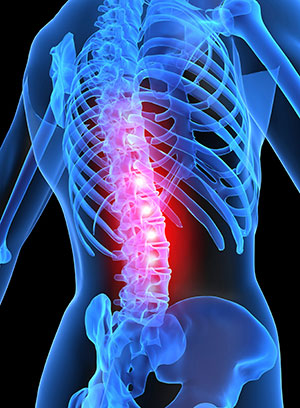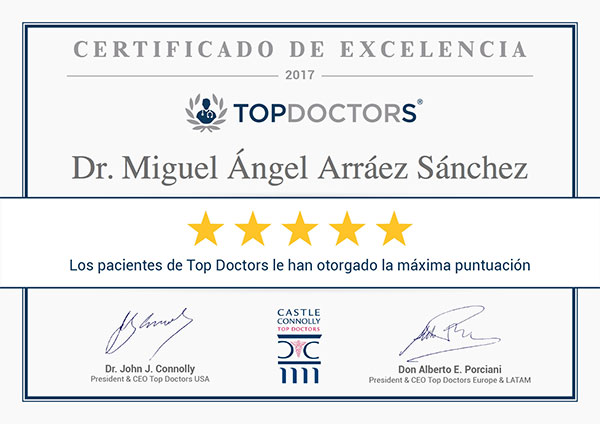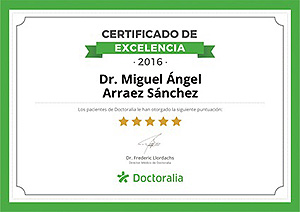Pathology of the spine
Treatment of Degenerative Illnesses in the Spine Spinal Column and Tumours

Symptoms of the spinal column are treated with the most innovative and beneficial technologies for the patient.
Degenerative alterations in the spinal column are frequent causes for sick leave. Cervicalgia, cervicobrachialgia, lumbalgia and sciatica are the most common diagnoses from these symptoms and they are caused by vertebral instability, disc degeneration, disc herniation, radicular, spondylolisthesis etc.
Currently conservative treatment is the first option when there is no neurological deficit.
When this first step fails, surgery offers various solutions depending on the cause of the pain: vertebral arthrodesis, dynamic stabilisation implants in the spinal column, arthoplasty and discectomy.
Minimally Invasive Techniques in Surgery on the Spinal Column
Minimally invasive techniques in surgery on the spinal column are advancing slowly but progressively. Special characteristics of surgery on the rachis means that advances are made more slowly and prudently while also taking more care of safety than in surgery in other parts of the human body.
Despite the difficulties, the possibility of using ‘minimally invasive’ techniques in the spinal column is perhaps more important and worthwhile than in other parts o the organism.
The approach to the rear part of the rachis severely damages the rear musculature and causes irreparable denervation, this can be the cause of surgical failure. The approach to the front part requires either an incision such as a thoracotomy, laparotomy or lumbotomy. All of these are very aggressive with undesirable side effects which may sometimes be permanent. It is extremely important to achieve results which are comparable to conventional surgery without most of the disadvantages.
What is Different about Minimally Invasive Surgery of the Spinal Column?
Traditional surgery of the spinal column requires large incisions in the back. The muscles are cut and are temporarily separated from the spinal column to allow access to the area. This causes large scars and, above all, leaves large areas of muscle denerved and devascularised. This causes the muscles to atrophy, at least in part, and they do not recover to work as they did before surgical intervention. In general there is much loss of blood the intervention is long. Given the nature of this surgery, it cannot be performed on people in a generally compromised state, be that due to old age or other co-existing illnesses (such as diabetes, high blood pressure, cardiac or pulmonary conditions and obesity). In contrast, minimally invasive surgery is carried out through small incisions in the back, causing small scars and minimal damage to muscle mass. For this reason recovery is quick with far fewer sequels than in traditional open-sky surgery but it requires complex equipment and specialist training for the surgeons. These techniques are not available in all hospitals nor offered by all surgeons. Therefore we conclude that although both kinds of surgery seek to correct problems at the spinal column and the nervous tissue contained within it, minimally invasive surgery attempts to minimise damage to the surrounding tissue (especially the muscles).
What are the Advantages and Risks of Minimally Invasive Surgery on the Spinal Column?
Minimally invasive surgery is used frequently for many surgical interventions such as the extirpation of the gallbladder or in surgery for obesity. Recently it has been used in interventions on the spinal column, including decompression and spinal fusion.
Minimally invasive surgery has many advantages over traditional surgery on the spinal column:
- Smaller incisions (less pain and a better result aesthetically)
- Less blood loss
- Shorter stay in hospital (which reduces costs)
- Less pain
- Less medication to control the pain
Earlier return to work and day-to-day life.
-
30 years of experience in spinal column surgery.
Our surgical experience allows us to offer patients reliable results, based on decisions tailored to your needs and on the latest medical findings. Studies are published daily which influence and change day-today medical practice. The members of the Arráez Institute team actively participate in these studies and we highly value the evaluation of results and the tested efficiency of the treatments. We offer up-to-date assistance in line with the latest scientific findings.
The medial research that we form an active part of, occasionally provides relevant information which allows us to identify which treatment is efficient and which is not. We only undertake treatment which has been shown to be effective through similar cases.
The results of the research are published daily in scientific journals. Our activity in the field of medical publications has been determinant in recent years.
Surgery on the spinal column has proved effective in treating pain due to nerve compression (disc herniation, canal stenosis) and for anomalous displaced vertebra which produce pain and deformities (spondylolisthesis, scoliosis). It also allows us to fix fractures, tumours and selected cases of vertebra infections. A number of commercial treatments lack foundation and scientific evidence.
Some patient conditions we have intervened in:
- Patients with disc herniation
- Patients with canal stenosis
- Patients with spondylolisthesis
- Patients with fractures
-
When to operate on a patient in pain
Surgery for patients with back ache is not very common.
The most recent scientific findings show that the majority of patients with degenerative backache do not get better with surgery although the pain caused by nerve compression does usually benefit from surgery. This is the guide for clinical practice for the most advanced countries in the world. Our multidisciplinary team offers non-surgical treatment to patients who do not need surgery and surgical treatment to those who may benefit from surgery.
Approximately 80% of the adult population will feel back pain at some point in their lives. In 90% of these cases the pain can be relieved without surgery.
In cases in which surgery is recommended, a detailed pre-operational examination should be carried out. Surgery should be performed by a surgical team with experience, optimising the probability of achieving a good result.
A poor choice by the patient and surgical techniques which do not match medical evidence, would mean it is likely that the operation will not achieve the desired results. At the Arráez Institute we are very careful in selecting patients and treatment in order to avoid unnecessary surgery and intervention.
When the pain is due to nerve compression (brachialgia, sciatica), it is usually manifested in the limbs. In these cases, if conservative treatment fails and once all non-surgical alternatives have been tried, surgery usually provides the best results.
Nerve decompression produces immediate relief from discomfort. It is performed using microsurgical techniques and on occasions may require vertebral instrumentation (such as bars and screws).
The stricter the selection process is for operating on patients, the better the results.
When to Operate on a Patient with a Spinal Fracture
Many spinal fractures can be treated without surgery.
It is recommendable to operate on fractures with medullar spinal cord compression and on those that cause considerable deformation of the spine. The aim of surgery is to decompress the medulla spinal cord or fix the fractured vertebrae in order to avoid deformation of the spinal column.
Surgery can be performed using minimally invasive techniques, injecting bone cement (PMMA) in selected patients (vertebroplasty).
When to Operate on a Patient with a Vertebral Spinal Tumor
The aim of surgery on spinal tumors is resection exerisis (extraction), the stabilization of the spinal column and the decompression of medulla.
When deciding whether to operate, it should be a multidisciplinary decision which should be taken after a detailed discussion of the case with a range of specialists (such as oncologists and radiotherapists).




